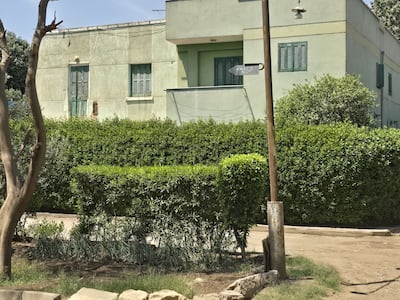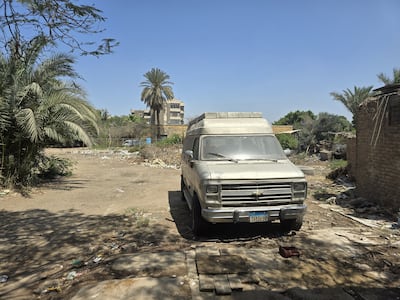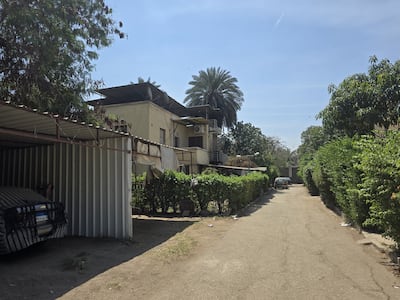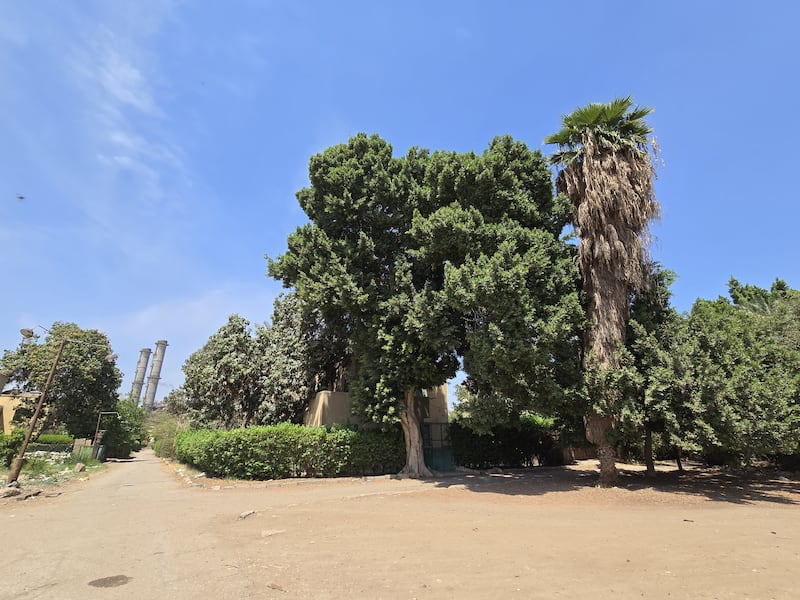Between the lower-income Cairo neighbourhood of Al Zaywa Al Hamra and the southern bank of the Ismailia canal lies one of Cairo’s oldest gated communities, the sparsely populated Al Mosta’mara – or The Colony in English.
Spanning an area of just over 230,000 square metres, the community is home to 7,000 to 8,000 people, and only houses employees of the neighbouring North Cairo Electricity Distribution Company.
The Colony was given its name because it served for decades as a barracks for British soldiers during the empire’s 80-year colonial presence in Egypt. The gated community stands out among its surroundings, including the neighbouring Madinat Al Ahlam, or The City of Dreams, a poorer area just beyond The Colony's southern wall.
“If I brought you here with a blindfold over your eyes and removed it, you would never guess that this was a part of Al Zawya Al Hamra,” said Ahmed Youssef, 38, a resident of a Madinat Al Ahlam. "Nothing about this place evokes any images one associates with a traditional low income neighbourhood anywhere in Cairo."
The Colony's abundant greenery is remarkable for Cairo, even compared to the city’s more affluent gated communities.
The Colony is home to dozens of species of tall tree, with shrubs of multi-coloured flowers, berries and fruit adding a cacophony of bright colours to the dense greenery.
The distance between homes in The Colony is also rare for Cairo, which is largely made up of densely populated neighbourhoods with apartment buildings crammed together.
Most of the homes in The Colony are villas of varying size with their own fenced gardens, with a smaller number of low-rise apartment blocks. The villas are inhabited by higher ranking officials of the electricity company and the flats by lower ranks.

“Is there any other place in Cairo where a man who makes just over minimum wage can live in a villa with a garden?” a resident of The Colony asked The National on Wednesday.
He preferred to remain anonymous because of several continuing lawsuits that he and other residents have filed against the state, which he said has been trying to acquire the settlement due to its prime location on the banks of the Ismailia canal and “the fresh air that comes to us from the nearby agricultural lands on the other side of the canal”.
The lawsuits are being filed against the Egyptian Electricity Holding Company, which has submitted multiple written requests for residents to clear the area. Many residents believe that the military will take over the area from the company as it has taken over other neighbourhoods in Cairo.
The nearby Almaza district, which was once home to employees of the Cairo Metro and the Heliopolis Company for Housing and Development, was demolished in 2022 and will be replaced by high-rise luxury homes whose construction is under way.
Partly due to these fears, residents of The Colony are generally very proud of their neighbourhood and are wary of outsiders whom they view as a threat to “our little piece of heaven,” the resident told The National.
However, living in the settlement, viewed by most residents as a rare privilege, comes with a number of caveats from the North Cairo Electricity Distribution Company, which manages the area and whose employees reside in its homes.
Buying, renting, subletting and selling houses within The Colony is banned. This applies even to existing residents.
The homes must be inhabited by workers of the electricity company, with their families allowed with them while they are employed.
However, a worker at the electricity company told The National that almost all residents find jobs for their children in the company to ensure they inherit the privilege of being allowed to live in The Colony.
“Most public-sector workers in Egypt try to find jobs for their children at whatever government agency employs them because, unlike the private sector, government jobs offer housing, pensions and health insurance, which many wouldn’t be able to afford otherwise,” they said.
Residents are also banned from altering their homes. One told The National that if they need to repair or rebuild parts of their homes, they do it at night to avoid the watchful eye of the electricity company regulators.
“People sneak building materials into the settlement because they don’t want to risk losing their homes by breaking the rules,” the resident said.
The ban on alterations and extensions has kept the settlement looking much the same as it did when it was first opened as housing for the workers in 1952. It was opened following a decree from Egypt’s last monarch, King Faruk I, who inaugurated the electricity company in 1948, said Mr Youssef Eweida, 81, a carpenter who has lived in the City of Dreams since the 1940s.

“The whole length of the Ismailia canal was home to many British army barracks, which were largely emptied when Britain pulled its troops out of Egypt to fight in the war with Germany [the Second World War]. Britain was always interested in the Suez Canal, which is why it stationed its troops along the road from Cairo to there,” he added.
The Colony is home to a nursery, a primary and a secondary school. It also houses one mosque and a post office. There are only a handful of shops open in the settlement due to the electricity company restricting the number of business permits.
“The company didn’t want the area to turn into another poor neighbourhood in Cairo where shops blast loud music well into the night with groups of young people loitering in the gardens and all that,” Mr Eweida said.
“That’s how we in Al Ahlam got to know the residents from Al Mosta’mara. They would come shop in our neighbourhood. There are only three small grocers and a bakery inside but no butcher or any other speciality stores.”
The schools, which were opened in 1952 with the settlement's inauguration, started out offering education to residents only.
However, in light of small class sizes, in the 1970s children from The City of Dreams and other neighbourhoods of Al Zawya Al Hamra were allowed to enrol in The Colony’s schools after a decree from the Education Ministry.
The ministry had received complaints that Al Zaywa Al Hamra’s schools were becoming overcrowded, said Nahla Eweida, 48, who was part of the first wave of outsider children to attend The Colony’s Primary School in 1976.
“It was the best time of my life,” Ms Eweida said. "We played hide and seek in the empty barracks before they were turned into other buildings. The nursery was opened in the same building, which had served as the morgue for the British army. When the teacher told us that on the first day of school, I had nightmares about it for months."
Despite The Colony’s beauty and its residents' pride in its distinction, it does bear many tell-tale signs of poverty, which can be seen in other areas in Cairo: heaps of rubbish are left to rot in its more remote corners and the streets are laden with dust.
The fate of The Colony remains in the balance. Residents are increasingly fearful that the Egyptian military, which has been progressively acquiring many of Cairo’s green spaces and turning them into more commercial operations, will do the same with their "little piece of heaven".









